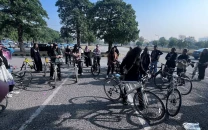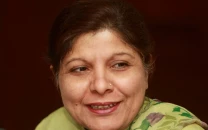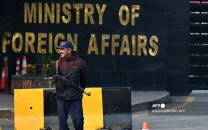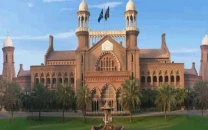Pakistan has highest living cost in Asia: ADB
Report projects 15% inflation rate for next FY
1712983198-0/iStock-1361391451-scaled-(1)1712983198-0-640x480.webp)
Pakistan has the highest living cost in whole of Asia with 25% inflation rate and its economy may grow at the fourth lowest pace of 1.9% in the region, read a new Asian Development Bank (ADB) report.
Released on Thursday, the Asian Development Outlook also painted a gloomy picture for the next fiscal year as well.
Published from Manila, the report has projected 15% inflation rate for the next fiscal year -- again the highest among 46 countries and a 2.8% growth rate -- the fifth lowest for FY2024-25.
The ADB stated that the inflation rate in Pakistan is expected to be 25% in the current fiscal year -- the highest in whole of Asia. This makes Pakistan the most expensive nation in Asia. Earlier, the cost of living in Pakistan used to be the highest in South Asia.
The State Bank of Pakistan (SBP) and federal government had set the inflation target at 21% for this fiscal year but they are going to miss it despite inflicting huge losses in the shape of a 22% interest rate.
The ADB said during the current fiscal year, the country’s economic growth rate might remain at 1.9% -- the fourth lowest after Myanmar, Azerbaijan and Nauru.
Pakistan is in a stagflation phase for a prolonged period and the World Bank too said last week that another 10 million more people might fall into the poverty trap because of any adverse shocks. About 98 million people are already living a poor life in Pakistan.
Despite these gravest conditions, Prime Minister Shehbaz Sharif and Finance Minister Muhammad Aurangzeb have the audacity to approve four salaries in reward for the already highly paid officers of the PM Office.
The total impact of the decision for the officers category will be over Rs50 million -- a sum that is enough to buy 34,247 kilogrammes of wheat at market prices. There is also a glaring similarity in the ADB and World Bank reports this time.
In the past, the ADB gave a rather optimistic economic scenario close to Pakistan’s official forecasts.
However, the latest ADB report stated that Pakistan would continue to face challenges from substantial new external financing requirements and the rollover of old debt, exacerbated by tight global monetary conditions.
The Manila-based lender said political uncertainty that affected the macroeconomic policy making would remain a key risk to the sustainability of stabilisation and reform efforts.
On the external front, the potential supply chain disruptions from escalation of the conflict in the Middle East negatively affect the country’s economy, it added.
The ADB said with Pakistan's large external financing requirements and weak external buffers, disbursement from multilateral and bilateral partners remained crucial.
The Manila-based lender cautioned that these inflows could be hampered by lapses in the policy implementation.
“Further IMF support for a medium-term reform agenda would considerably improve market sentiment and catalyse affordable external financing from other sources,” the report added.
Federal Finance Minister Muhammad Aurangzeb is set to meet the IMF Managing Director Kristalina Georgieva next week in Washington to request a new bailout package.
The IMF MD said this week that Pakistan was in discussions for a potential follow up programme.
However, she said that there are “very important issues” to be solved in Pakistan: the tax base, how the richer part of the society contributed to the economy, the way public spending is being directed, and creating a more transparent environment.
The IMF has in the past raised questions over the lack of transparency in the affairs of the Sovereign Wealth Fund and the Special Investment Facilitation Council (SIFC).
In Pakistan, rising administered energy prices will keep inflation high at 25% in this fiscal year and 15% in FY2025, the ADB said.
The Manila-based lender said challenges remained in sustaining reforms given the substantial debt servicing costs in Pakistan and Sri Lanka.
In Pakistan, fiscal revenues remain weak with rising interest payments expected to consume 63% of budget revenues against 39.5% in 2022.
The ADB noted that adhering to the economic adjustment programme was critical to restoring macroeconomic stability and the gradual recovery of growth.
“Pakistan’s economy is showing signs of a gradual recovery supported by higher crop output and improvement in manufacturing,” said ADB Country Director for Pakistan Yong Ye.
He added that growth was forecast to resume in 2024 and strengthen in 2025.
However, he observed that the continued implementation of policy reforms was crucial to buttressing this momentum as well as fortifying the country’s fiscal and external buffers.
In the last fiscal year, Pakistan’s economy contracted due to lingering impacts of 2022’s devastating floods; uncertainty; policy slippage; as well as weakened production, consumption, and investment, the ADB pointed out.
The report further read that Afghanistan’s currency had become stronger against the Pakistani rupee.
“The Afghani appreciated against the Pakistan rupee and the Iranian riyal, the currencies of the country's main import suppliers,” it continued.
The appreciation of the two neighbouring countries’ currencies against the Pakistan rupee has likely maintained deflation for the entire fiscal year 2024 in Afghanistan given the high pass through of exchange rate changes into inflation.
The ADB said low confidence, a surge in living costs, and the implementation of tighter macroeconomic policies under the IMF programme would restrain domestic demand in Pakistan.
It said the government’s goal was to achieve a primary surplus of 0.4% and an overall deficit of 7.5% of GDP in FY2024, with both declining gradually in subsequent years.
However, the World Bank said last week that Pakistan would miss both these budget targets.
The ADB said the revenue mobilisation was expected to strengthen in the medium term, reflecting planned reforms to broaden the tax base.
A rise in interest payments equal to 1% of GDP from higher rates boosted expenditure to 8.8% of GDP in the first half of FY2024 from 7.6% a year earlier.
“Fiscal consolidation will also benefit from plans to rationalise current expenditure,” the ADB report predicted.
The relaxation of import restrictions, coupled with economic recovery, is expected to widen the current account deficit, the ADB observed.
“Thus, the current account deficit is projected to widen to 1.5% of GDP in FY2024.”
A transition toward a market-determined exchange rate is expected to encourage remittance inflows through official channels, thus enhancing the economy's resilience under future external shocks, the report added.



















COMMENTS
Comments are moderated and generally will be posted if they are on-topic and not abusive.
For more information, please see our Comments FAQ